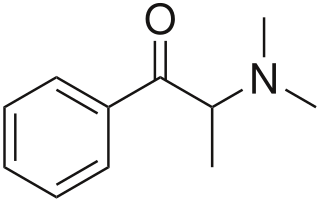
Metamfepramone is a stimulant drug of the phenethylamine, and cathinone chemical classes. Dimethylcathinone was evaluated as an appetite suppressant and for the treatment of hypotension, but was never widely marketed.

Ethylone, also known as 3,4-methylenedioxy-N-ethylcathinone, is a recreational designer drug classified as an entactogen, stimulant, and psychedelic of the phenethylamine, amphetamine, and cathinone chemical classes. It is the β-keto analogue of MDEA ("Eve"). Ethylone has only a short history of human use and is reported to be less potent than its relative methylone. In the United States, it began to be found in cathinone products in late 2011.

Methylenedioxypyrovalerone is a stimulant of the cathinone class that acts as a norepinephrine–dopamine reuptake inhibitor (NDRI). It was first developed in the 1960s by a team at Boehringer Ingelheim. Its activity at the dopamine transporter is six times stronger than at the norepinephrine transporter and it is virtually inactive at the serotonin transporter. MDPV remained an obscure stimulant until around 2004 when it was reportedly sold as a designer drug. In the US, products containing MDPV and labeled as bath salts were sold as recreational drugs in gas stations, similar to the marketing for Spice and K2 as incense, until it was banned in 2011.

Mephedrone, also known as 4-methylmethcathinone, 4-MMC, and 4-methylephedrone, is a synthetic stimulant drug of the amphetamine and cathinone classes. Slang names include drone, M-CAT, White Magic, meow meow and bubble. It is chemically similar to the cathinone compounds found in the Khat plant of eastern Africa. It comes in the form of tablets or crystals, which users can swallow, snort or inject, producing effects similar to those of MDMA, amphetamines and cocaine.

Ethcathinone, also known as ethylpropion or ETH-CAT, is a stimulant drug of the phenethylamine, amphetamine, and cathinone chemical classes. It is an active metabolite of the prodrug diethylcathinone and is fully responsible for its effects. Ethcathinone has been identified as an ingredient in both quasi-legal "party pills", and, along with mephedrone, has also been reported as having been sold as "ecstasy" in the Australian city of Cairns.

Dimethocaine, also known as DMC or larocaine, is a compound with a stimulatory effect. This effect resembles that of cocaine, although dimethocaine appears to be less potent. Just like cocaine, dimethocaine is addictive due to its stimulation of the reward pathway in the brain. However, dimethocaine is a legal cocaine replacement in some countries and is even listed by the European Monitoring Centre for Drugs and Drug Addiction (EMCDDA) under the category “synthetic cocaine derivatives”. The structure of dimethocaine, being a 4-aminobenzoic acid ester, resembles that of procaine. It is found as a white powder at room temperature.

4'-Methyl-α-pyrrolidinopropiophenone is a stimulant drug and substituted cathinone. It is structurally very similar to α-PPP, with only one added methyl group in the para position on the phenyl ring. 4-MePPP was sold in Germany as a designer drug in the late 1990s and early 2000s, along with a number of other pyrrolidinophenone derivatives. Although it has never achieved the same international popularity as its better-known relations α-PPP and MDPV, 4-MePPP is still sometimes found as an ingredient of grey-market "bath salt" blends such as "NRG-3".

MDAI (5,6-methylenedioxy-2-aminoindane) is a drug developed in the 1990s by a team led by David E. Nichols at Purdue University. It acts as a non-neurotoxic and highly selective serotonin releasing agent (SSRA) in vitro and produces entactogen effects in humans.

3',4'-Methylenedioxy-α-pyrrolidinobutyrophenone (MDPBP) is a stimulant of the cathinone class developed in the 1960s, which has been reported as a novel designer drug. MDPBP is sometimes sold under the name "NRG-1" as a mixture with other cathinone derivatives, including flephedrone, pentylone, MαPPP and its higher homologue MDPV. As with other cathinones, MDPBP has been shown to have reinforcing effects in rats.

Naphyrone, also known as O-2482 and naphthylpyrovalerone, is a substituted cathinone drug derived from pyrovalerone that acts as a triple reuptake inhibitor, producing stimulant effects and has been reported as a novel designer drug. No safety or toxicity data is available on the drug.

3-Fluoromethcathinone is a chemical compound of the phenethylamine, amphetamine, and cathinone classes that has been sold online as a designer drug. It is a structural isomer of flephedrone (4-fluoromethcathinone).

Pentylone is a stimulant developed in the 1960s. It is a substituted cathinone. It has been identified in some samples of powders sold as "NRG-1", along with varying blends of other cathinone derivatives including flephedrone, MDPBP, MDPV and 4-MePPP. It was also found in combination with 4-MePPP being sold as "NRG-3". Reports indicate side effects include feelings of paranoia, agitation and inability to sleep, with effects lasting for several days at high doses.

4-Ethylmethcathinone (4-EMC) is a recreational designer drug of the stimulant and entactogen class. It is a structural isomer of 4-MEC and 3,4-DMMC. It has been identified in many countries around the world, initially in Europe but was first found in Australia in 2020.
Bath salts are a group of recreational designer drugs. The name derives from instances in which the drugs were disguised as bath salts. The white powder, granules, or crystals often resemble Epsom salts, but differ chemically. The drugs' packaging often states "not for human consumption" in an attempt to circumvent drug prohibition laws. Additionally, they may be described as "plant food", "powdered cleaner", or other products.

N-Ethylbuphedrone is a stimulant of the cathinone class that has been sold as a designer drug. It is the β-ketone analogue of N,alpha-diethylphenylethylamine.

3-Methylmethcathinone (3-MMC), also known as metaphedrone, is a designer drug from the substituted cathinone family. 3-MMC is a monoamine transporter substrate that potently inhibits norepinephrine uptake and displays more pronounced dopaminergic activity relative to serotonergic activity, compared to mephedrone. Unlike some synthetic cathinones, 3-MMC has been evaluated in at least one large mammal study.

4-Methylcathinone, is a stimulant drug of the cathinone chemical class. It is a metabolite of the better known drug mephedrone (4-methylmethcathinone).

2-Methylmethcathinone (2-MMC), also known as ortomephedrone is a recreational designer drug with stimulant and euphoric effects. It is a substituted cathinone derivative, closely related to better known drugs such as 3-methylmethcathinone and 4-methylmethcathinone (mephedrone). It was first identified in Sweden in 2014, and has subsequently been reported in other European countries such as Poland and Spain.

BMAPN (βk-methamnetamine) is a substituted cathinone derivative with stimulant effects. It inhibits dopamine reuptake and has rewarding and reinforcing properties in animal studies. It is banned under drug analogue legislation in a number of jurisdictions. The drug was at one point marketed under the name NRG-3, although only a minority of samples of substances sold under this name have been found to actually contain BMAPN, with most such samples containing mixtures of other cathinone derivatives.

25T7-NBOMe is a substituted phenethylamine derivative from the 25-NB family. It acts as an agonist at the 5-HT2A and 5-HT2C serotonin receptors, has psychedelic effects and has been sold as a designer drug.



















